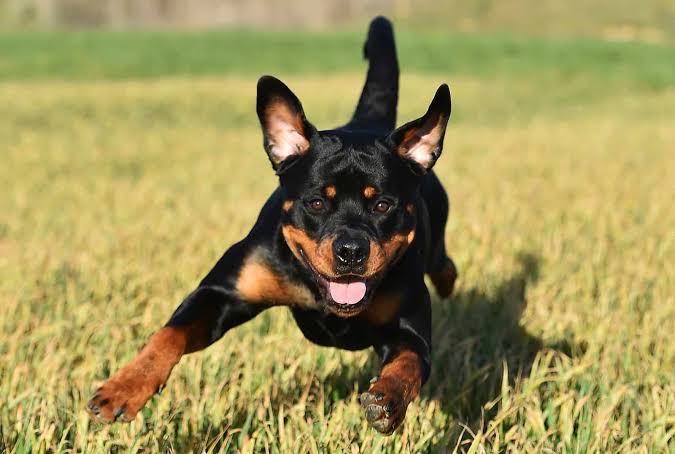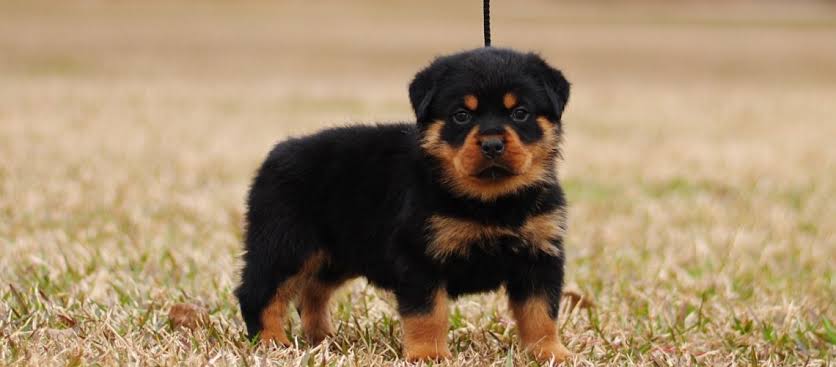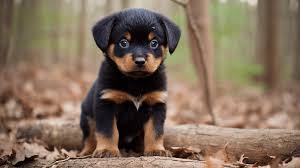Some Rottweiler owners inquire about a Rottweiler runt growth chart after discovering that their dog is growing much slower than expected. Although this is rarely a cause for concern, it is possible that your Rottweiler is a runt. In today’s article, we’ll look at a Rottie’s growth to determine whether your puppy is a runt.

A Rottweiler runt is often the smallest and weakest puppy in the litter, often because it receives less milk. However, many runts gain size and weight as they mature. Here’s an overall growth chart for Rottweilers, including runts:
Rottweiler Growth Chart (General):
Table
| Age | Ideal Height (inches) | Ideal Weight (lbs) |
| 4 weeks old | 6-8 | 5-8 |
| 8 weeks old | 8-10 | 10-15 |
| 3 months old | 14-17 | 30-40 |
| 6 months old | 17-20 | 50-65 |
| 1 year old | 23-27 | 80-100 |
| 2 years old | 24-27 | 95-135 |
Male Rottweilers would be termed runts if they were shorter than 24 inches and weighed less than 100 pounds, while females would be shorter than 22 inches and lighter than 80 pounds.
Remember, these are ideal ranges; individual dogs may differ. Regular vet visits are essential for monitoring your Rottweiler’s health and growth. If you are concerned about your Rottweiler’s growth, consult with a veterinarian.
Regular Rottweiler Growth

Certainly! Here’s a thorough growth chart for a typical Rottweihttps://rottweilerscare.com/category/blog/ler that shows the projected height and weight at different phases of development:
Male Rottweiler Growth Chart:
Table
| Age | Ideal Height (inches) | Ideal Weight (lbs) |
| 4 weeks old | 6-8 | 5-8 |
| 8 weeks old | 8-10 | 10-15 |
| 3 months old | 14-17 | 30-40 |
| 4 months old | 15-18 | 35-50 |
| 5 months old | 16-19 | 40-55 |
| 6 months old | 17-20 | 50-65 |
| 7 months old | 18-22 | 55-70 |
| 8 months old | 19-23 | 60-75 |
| 9 months old | 20-24 | 65-80 |
| 10 months old | 21-25 | 70-85 |
| 11 months old | 22-26 | 75-90 |
| 1 year old | 23-27 | 80-100 |
| 2 years old | 24-27 | 95-135 |
| 3 years old | 24-27 | 95-135 |
This chart provides broad principles; individual pets may differ. A healthy lifestyle, correct nutrition, and frequent veterinary check-ups are critical to your Rottweiler’s growth and overall well-being.
For more information, see the resources listed in the search results.
What is a Runt?

A runt is the tiniest and weakest animal in a litter born at the same time. Because of their small, runts frequently experience obstacles such as competing with siblings for nutrients and may even be rejected by their mother. In the wild, this can mean a decreased survival rate. Not all litters contain runts, and being the smallest does not automatically qualify an animal as a runt; it refers especially to those that are undeveloped or less fit due to nutrient deficiency or genetic causes.
How Can Dogs Become Runts?
Poor placentation during a dog’s growth in the womb is the primary cause of runthood. This signifies that the placenta, which transports nutrition and oxygen from the mother to the fetus, is not performing effectively for the runt. As a result, the runt receives less nutrients than its littermates, resulting in a smaller size and probably poorer health upon birth.
It is a widespread myth that a runt is the puppy conceived last or placed in the center of the uterus, but these notions have been disproven. Instead, the quality of the placental attachment determines a puppy’s size and vitality at birth.
Is my dog a runt?
There are various criteria to consider when determining whether or not your dog is a runt. A runt is usually the tiniest and weakest puppy in a litter, frequently due to poor placental attachment and nutrition during development. Here are several indicators that could suggest your dog is a runt:
Size at Birth: Runts are often the smallest at birth.
Growth Rate: They may grow at a slower rate than their littermates.
Health Issues: Runts may face additional health issues in the beginning.
Strength and Vitality: They may be less active or possess less stamina than their siblings.
If you suspect your dog is a runt, give him extra care and attention. Ensure that they receive proper diet, regular veterinary check-ups, and plenty of affection. With the right care, runts can grow up to be as healthy and happy as their littermates.
What are some typical health issues among runts?
Runts, who are frequently the tiniest and weakest members of a litter, might encounter a variety of health issues. Runt dogs frequently experience the following health issues:
Runts usually have a lower birth weight, which can cause a number of developmental issues.
Undernourishment: Because of their small size, runts may struggle to compete for nutrients with siblings, resulting in malnutrition.
Runts have a poor immune system, which makes them more susceptible to infections and illnesses.
Respiratory Infections: Because of their frailty, they are more vulnerable to respiratory infections.
Runts might struggle to control their body temperature, rendering them susceptible to hypothermia.
Hypoglycemia is a typical problem since runts do not eat as regularly or as much as their littermates.
Gastrointestinal Disorders: Digestive issues may arise, particularly if the runt has difficulties feeding adequately.
Congenital Diseases: Runts are more likely to have birth problems such cleft palate, dwarfism, and cardiovascular irregularities.
Runts require special care, such as frequent feeding, warmth, and regular veterinary check-ups, to address and avoid these disorders. With the right care, many runts can overcome their initial difficulties and enjoy healthy lives.
How fast do baby Rottweilers grow?

Baby Rottweilers grow quickly, especially during the first several months. Here’s a quick summary of their growth rate:
0-2 weeks: Puppies are fully reliant on their mother for sustenance and begin to open their eyes and hear sounds.
1 month: Puppies become more energetic and start socializing and playing with their littermates.
They are totally weaned and ready to leave their mother at two months. They should be provided a comprehensive puppy diet.
At 6 months, Rottweilers reach around 75% of their mature height and 66% of their adult weight.
8-9 months: The growth rate slows, but the puppies continue to gain weight.
They achieve their full height between 12 and 18 months, after which they continue to fill out and add muscle until they are around 2-3 years old.
A Rottweiler puppy will gain approximately 2.2 pounds (1 kilogram) per week until 8-9 months of age. It is critical that they receive adequate nourishment and regular veterinarian care to encourage their rapid growth and avoid any potential health problems associated with their development.
conclusion
To summarize, Rottwehttps://rottweilerscare.com/category/blog/ilers are a robust breed that grows rapidly, especially in the first year of life. While runts may begin smaller and experience greater health issues, with adequate care, they frequently catch up with their littermates. All Rottweiler puppies, runt or not, require balanced nutrition, frequent veterinarian care, and a caring environment to thrive and realize their full potential. Remember that each dog is unique, and their growth rates may differ. Regular veterinary check-ups will guarantee that your Rottweiler is healthy and growing normally.
